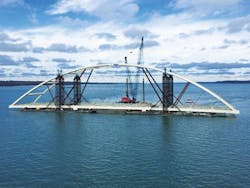If there was a working template in place, it wasn’t for very long. The Kentucky Lake Bridge project was saturated in highly complex challenges, and perhaps the highest-ranked one involved setting 330,000-lb piles in place. The process involved a template that was floated into place and used to guide the piles, which were up to 199 ft long, 6 ft in diam. and came with 2-in.-thick steel walls, into place. Using an upper and lower template, a hydraulic gate would open up, the pile was swung into position, the gate was closed and the pile, equipped with constrictor plates, was hammered down to resistance. There were over 9,200 kips of resistance in each pile, and some are positioned over 100 ft deep.
Crews could easily set one pile a day before moving to the next one. Unfortunately, it would take some time to relocate the template, so on average about three piles—out of a total of 51—were placed per week.
“The time-consuming part was moving the template,” Mike Brown, project manager for Johnson Bros. Corp., told Roads & Bridges. “Your biggest challenge was the depth. [The piles] had to be within a 3-in. tolerance. That is not a simple task.”
It didn’t stop there. Before crews could even make use of the template, they had to figure out a way to move the 330,000-lb piles from a horizontal position to a vertical position. A one-of-a-kind system was designed that used two ringer cranes, a roller system and a whip line. One ringer crane would set a pile on Hillman rollers. A second ringer crane, one that had a whip line, would hold the tail end of the pile.
“So we would take the whip line and bring it taut dropping the choker off of the bottom of the pile and swing it into position with the other ringer, avoiding the need for a dive team,” said Brown.
Innovation spread to the truss erection sequence, where four barges were essentially welded together to form one big unit to move the 550-ft-long, 110-ft-high basket-handle arch main span into place. Lifting towers were erected on the barge and huge strand jacks were brought in from Switzerland. The arch was lifted about 75-80 ft vertically before it was moved laterally with air tuggers that were attached to the barges. The main span was then lowered down onto bearings and welded down.
Each footer (12-ft-diam. columns) the main span sits on contains well over 2,500 cu yd of concrete. The caps were made of 500 cu yd of concrete, and had to be handled by hand.
The bridge is located just 80 miles from the New Madrid fault line. Some of the approach piers only have three pilings to make them more elastic. End bearings on the approach spans allow up to 12 in. of longitudinal movement and modular joints on each side of the main span allow for another 24 in. longitudinally and ±9 in. transversely. The main span also sits on lead core elastomeric isolation bearings that allows up to 9 in. of seismic displacement.
Project: Kentucky Lake Bridge
Location: Western Kentucky
Owner: Kentucky Transportation Cabinet
Designer: Michael Baker Intl.
Contractor: Johnson Bros. Corp.
Cost: $132 million
Length: 3,600 ft
Completion Date: April 2016



